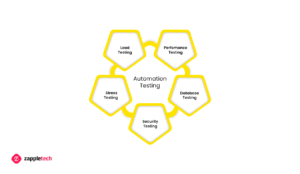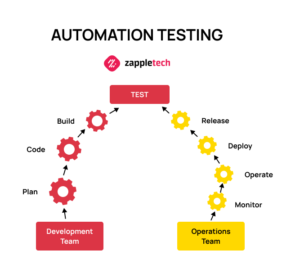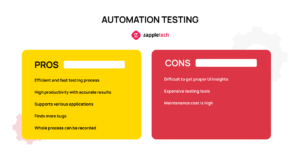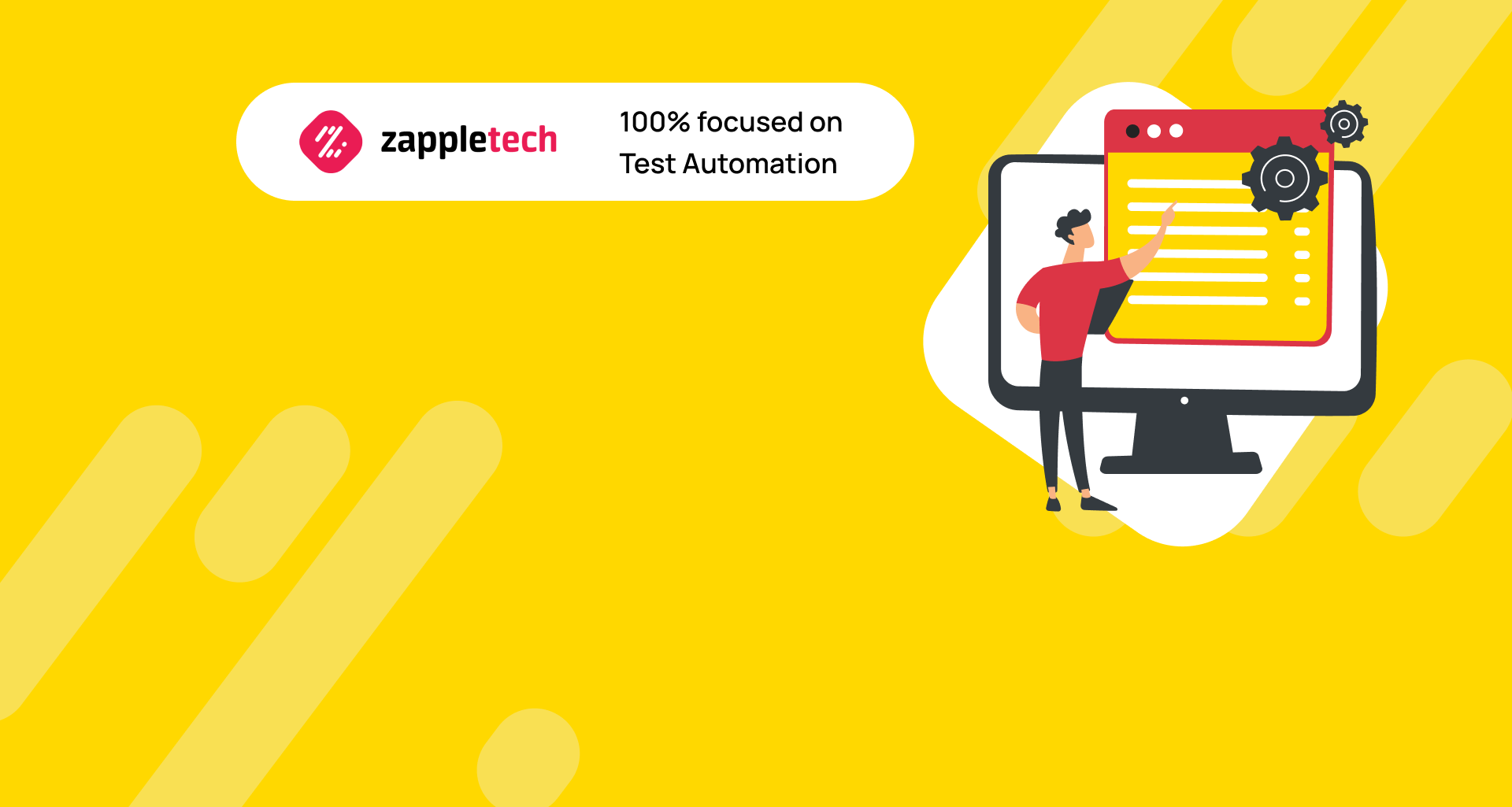The viability of an IT project depends entirely on the number of bugs found in the release version. It’s obvious that most are fixed after the finished product is released, but the first user experience affects its further development and community support. According to Microfocus, 72% of respondents believe that bugs discovered during development are easier to fix than those that surfaced after release. We agree with this 100%, especially since the effectiveness of QA has increased with modern Agile and DevOps methods, much more powerful compared to the outdated Waterfall.
Talking about current SQA practices, we mean a complex of all testing types. They check the major part of IT product functionality. In fairness, we note that automation is not a panacea in finding bugs, but it is an additional tool for professionals. Manual and automated testing are integral components of QA in general. There are no tasks that can be done 100% with just one of these methods. Implementing automated software testing significantly enhances the overall efficiency and accuracy of the QA process, ensuring that repetitive and complex test cases are handled swiftly and effectively.
ZappleTech experts have conducted QA research for IT products. In this article, you will learn what challenges SQA solves and when to use automation testing. This includes understanding the balance between manual and automated testing and how implementing automated software testing can lead to more robust and reliable IT products.
Table of Contents
Why automation testing is required

In the evolving landscape of software development, automation testing has become an essential component for ensuring high-quality releases. The primary reason automation testing is required is its ability to execute repetitive tasks efficiently, thereby reducing human error and increasing the speed of test execution. By implementing automated software testing, teams can focus on more complex tasks that require human intelligence, such as exploratory testing and usability testing.
Despite the popularity of automation, many experts ask a reasonable question concerning when to use automation testing: in a sprint, between cycles, or at a certain stage of development. This question highlights the need for strategic planning in the automation process. Implementing automated software testing during sprints can be highly beneficial as it allows for continuous integration and continuous delivery (CI/CD) practices, ensuring that any code changes are immediately tested and validated. This approach helps in identifying issues early, reducing the cost and effort required for fixing bugs later in the development cycle.
On the other hand, using automation testing between development cycles can ensure that the application remains stable as new features are integrated. This period is ideal for running regression tests to verify that existing functionalities are not adversely affected by new code changes. By strategically placing automated tests at this stage, teams can maintain the integrity of the application while accelerating the development process.
There is also a case for implementing automated software testing at certain stages of development, particularly in scenarios involving complex or critical systems. For instance, performance testing and load testing are often automated and conducted in the later stages of development to ensure the application can handle expected user loads and perform optimally under stress. By automating these tests, teams can simulate various scenarios and environments, providing comprehensive insights into the application’s performance.
In conclusion, the need for automation testing is driven by the desire to improve efficiency, accuracy, and speed in the software development lifecycle. By carefully considering when to implement automated software testing—whether in a sprint, between cycles, or at a specific development stage—teams can maximize the benefits of automation and deliver high-quality software more reliably and faster.
Introducing test automation early in your project can save time and resources in the long run. Begin by automating repetitive, time-consuming tasks and gradually expand to cover more complex scenarios. This approach ensures a solid foundation and allows your team to adapt to the automation process incrementally.Mykhailo PoliarushCEO, ZappleTech Inc.
Responsibilities of QA staff:
- Planning. From the early development stages, they write scripts and cases for testing vital features.
- Creating instructions. Initially, this task was performed by contractors who sometimes even did not know how the application worked.
- Testing. QA specialists manually check the implementation of a module or component according to received specifications.
- Analysis. Generating reports and describing situations based on the results of the check.
- Delegating. After comparing bug reports, testers delegate tasks to programmers who promptly fix the bug.
- Control. After the developers respond that the problematic element of the code is fixed, the QA department rechecks it for errors.
These are the basic functions of SQA that even beginners in the field can easily handle. The main problem arises when tested data exceeds the human and time resources planned for the development sprints. This is where automation comes to the rescue.
Test Automation: A Powerful Tool in the Hands of a Pro
Many users who are not familiar with the nuances of QA believe that automation is about running a script and resting while it checks something. Alas, we are still very far from this. Even AI and ML are unlikely to fully automate this job in the near future.
Implementing automated software testing is a complex and painstaking process that requires performers with an IT background in coding and a little creativity. This procedure involves using dozens of tools, each responsible for checking a particular function and containing an arsenal of editors, constructors, and loggers.
The main requirement for a QA specialist is understanding when and why automation is used. It can speed up the testing process or completely stall it, increasing expenses significantly. Therefore, the benefits and risks must be carefully analyzed before starting. When implementing automated software testing, it’s crucial to balance the need for speed with the need for accuracy.
One of the key aspects of successfully implementing automated software testing is choosing the right tools for the job. There are various tools available, each with its own strengths and weaknesses. For example, some tools excel at GUI testing, while others are better suited for API testing. Selecting the appropriate tool based on the specific needs of the project is vital to achieving efficient and effective test automation.
Furthermore, developing robust test scripts is essential for reliable automated testing. These scripts should be well-documented and maintainable, allowing for easy updates and modifications as the software evolves. Incorporating best practices such as modularization and reusability can significantly enhance the maintainability of test scripts.
Another important consideration is the integration of automated testing into the CI/CD pipeline. Continuous integration and continuous delivery ensure that automated tests are run frequently, providing immediate feedback on the quality of the software. This integration helps catch issues early, reducing the cost and effort required to fix them later in the development cycle.
Finally, while automated testing can significantly enhance efficiency and coverage, it’s important to remember that it cannot replace manual testing entirely. Manual testing is still necessary for exploratory testing, usability testing, and scenarios that require human judgment and intuition.
In summary, implementing automated software testing involves a strategic approach, careful tool selection, robust test script development, and seamless integration into the CI/CD pipeline. By balancing automation with manual testing, QA teams can ensure comprehensive and reliable software testing.
The Importance of Skilled QA Specialists
Skilled QA specialists are indispensable in the process of implementing automated software testing. Their expertise ensures that the right tools and methodologies are applied effectively. Automation in testing isn’t just about writing scripts; it involves designing test cases, setting up test environments, and analyzing test results. This requires a deep understanding of both the software being tested and the tools used for automation.
When implementing automated software testing, QA specialists must have a comprehensive grasp of the software’s architecture and functionality. They need to identify critical areas that require testing and determine the best approach for automating those tests. This often involves creating detailed test plans that outline the scope, objectives, and execution steps for the automation process.
Additionally, skilled QA specialists are adept at selecting the most appropriate automation tools for the task. With a plethora of tools available, each designed for specific testing needs, making the right choice is crucial. These professionals evaluate the tools based on factors such as compatibility, ease of use, scalability, and integration capabilities. Their decisions directly impact the efficiency and effectiveness of the automated testing process.
Moreover, the process of implementing automated software testing demands meticulous attention to detail and a systematic approach. QA specialists must ensure that the test environments are configured correctly and that all dependencies are accounted for. They also need to design test cases that cover a wide range of scenarios, including edge cases and potential failure points. This thoroughness helps in identifying issues early in the development cycle, reducing the likelihood of defects in the final product.
Tools of the Trade
Balancing Automation with Manual Testing
While automation is a powerful tool, it doesn’t replace the need for manual testing. Certain tests, especially those requiring human judgment, are best performed manually. Implementing automated software testing should complement manual testing, not replace it. A balanced approach ensures comprehensive test coverage and high-quality software.
Automated testing excels in handling repetitive tasks, running extensive test cases quickly, and improving overall efficiency. However, manual testing is invaluable for exploratory tests, usability testing, and scenarios requiring a nuanced understanding of the user experience. By implementing automated software testing alongside manual testing, teams can leverage the strengths of both methods. Automated tests can handle the bulk of routine checks, freeing up human testers to focus on more complex and subjective test cases. This synergy between automation and manual efforts leads to a more robust and reliable testing process.
Moreover, the integration of automated testing tools can help identify bugs and issues early in the development cycle, which can significantly reduce the time and cost of fixing them later. Meanwhile, manual testing remains crucial for validating user interfaces and ensuring that the software behaves as expected under varied real-world conditions. Implementing automated software testing, therefore, doesn’t mean sidelining manual testers but rather enhancing their capacity to deliver high-quality results through a combined approach.
Continuous Improvement and Adaptation
The field of automated testing is continuously evolving. New tools and techniques are constantly emerging, making it essential for QA specialists to stay updated with the latest trends. Implementing automated software testing successfully requires a commitment to continuous learning and adaptation. This not only improves the testing process but also ensures that the QA team can tackle new challenges as they arise.
One of the keys to successful implementation is the willingness to embrace change and experiment with new tools and methodologies. By staying informed about the latest advancements in automated testing, QA teams can integrate cutting-edge solutions that enhance efficiency and accuracy. This proactive approach allows teams to optimize their testing strategies continually, ensuring they remain effective in a rapidly changing technological landscape.
Moreover, implementing automated software testing isn’t a one-time effort. It demands regular review and refinement of test scripts, processes, and tools. As software evolves, test cases need to be updated to reflect new features and functionalities. This iterative process helps maintain the relevance and reliability of automated tests, making sure they accurately assess the quality of the software throughout its lifecycle.
When to use automation testing

Despite the popularity of automation, many experts ask a reasonable question concerning when to use automation testing: in a sprint, between cycles, or at a certain stage of development.
It’s difficult to answer this because many factors influence this:
- Knowledge of the future software’s features.
- The number of QA personnel involved.
- The amount of work on the project.
- Deadlines for the final product.
- Duration and number of sprints.
- Manual check speed.
- Modularity or solidity of the program.
- Implemented and planned functions.
It is an indicative list. It varies depending on the type of IT product being implemented, the deadline, and the technical stack. Sometimes automation does not even pay off. Primarily, it is due to the cost of tools and skills of SQA specialists.
How to automate: Free vs. Paid
When considering how to automate your processes, it’s essential to understand the differences between free and paid automation programs. Free tools, often open-source, offer high customizability and flexibility. These tools allow users to modify and extend functionalities according to their specific needs. On the other hand, paid tools, while sometimes perceived as limited in potential, provide comprehensive support, advanced features, and regular updates.
Each tool, whether free or paid, comes with its own set of commands and supported scripting and programming languages. This diversity can pose challenges when implementing automated software testing, as the compatibility and ease of integration with existing systems must be carefully evaluated. Selecting the right software for test automation requires a thorough analysis of your project’s needs, including the technical skills of your team and the specific testing requirements of your applications.
Ultimately, the choice between free and paid automation tools hinges on various factors, including budget, project complexity, and the desired level of support and functionality. By carefully weighing these considerations, you can make an informed decision that best supports your automated software testing initiatives.
Prioritize automating tests for critical and frequently used functionalities. This ensures that the most important parts of your application are consistently tested, reducing the risk of major issues in production. Automating tests for high-impact areas provides immediate value and builds confidence in your automation strategy.Sergey AlmyashevCOO, ZappleTech Inc.
General recommendations for selecting programs for automation:
- Estimate your budget and do not pay for unnecessary functions.
- Choose a product according to your development methods.
- Check the tool’s stack support.
- Explore several scripting languages and pick the most suitable one.
- Decide on a payment model in advance.
- Use a solution that is convenient for you and train your employees.
If you have difficulties with choosing a test automation tool, you can contact us. ZappleTech consultants will offer you the best options that our company’s QA specialists use.
When to automate testing: start, middle, or end of development
Test automation is a crucial aspect of modern software development. However, one common question developers and QA teams face is: When is the right time to start implementing automated software testing? Should it be at the start, middle, or end of the development process? The answer largely depends on the project’s specifics, but understanding the benefits and challenges of each stage can help make an informed decision.
Start of Development
Starting automated testing at the beginning of the development process has several advantages. It allows for the integration of testing early in the lifecycle, ensuring that tests are run alongside the development of new features. This approach helps in catching bugs early when they are easier and cheaper to fix. Additionally, writing tests as code is developed ensures that automated testing becomes an integral part of the development culture.
However, this approach requires a well-defined project scope and stable requirements. If the project is still in flux, the effort spent on creating automated tests might need constant updates, which can be time-consuming.
Middle of Development
Implementing automated software testing in the middle of the development process strikes a balance between early and late testing. By this time, the project’s requirements are likely more stable, reducing the need for frequent changes to the test scripts. Automated tests can help catch issues that manual testing might miss, ensuring that the product’s core functionality is robust before moving into the final stages of development.
This phase also allows for the optimization of the test automation framework based on the initial manual testing results, ensuring that the automated tests are targeting the most critical and high-risk areas.
End of Development
Automating tests at the end of development is often seen as a last-minute effort to ensure quality before release. While this approach can be effective for regression testing and ensuring that the latest code changes haven’t broken existing functionality, it has its drawbacks. Fixing bugs at this stage can be costly and time-consuming, and the pressure to meet release deadlines can result in less thorough testing.
Here are some steps to prepare for testing automation properly:
- Write a complete testing plan, including all methods, regression, and both inter-sprint and final QA. Consider every point, even the smallest ones.
- Explore the project, starting with the prototype and the implemented functionality, and ending with the essential functions included in the roadmap.
- Prepare cases and describe each action to be performed step by step. Consider the expected results and potential situations.
- Analyze cases and divide them into two groups: those that can be done manually or automated. Revise the lists once again and make the final list of functions to test.
- Distribute responsibilities among team members. Delegate manual tests to beginners and mid-level specialists. Automatic tests are better to be provided by your professionals or outsourced.
- After the SQA group launches simultaneous testing, study the results and submit critical bug reports to the developers.
It is best to prepare for automation from the first hours of the project launch. It is important to separate the priority tasks and the secondary ones, focusing on the main MVP functionality. You should also consider regression testing, plan it during the sprint, and write scripts before moving on to the next step.
Problems of Test Automation
As we mentioned before, test automation is not perfect. Its main cons are a high threshold of entry, strict requirements for QA specialists’ skills, and routine scripting. Also, with urgent changes in the project, inconsistencies with the test case may arise when the solution needs to be rewritten from scratch or painstakingly edited.
Another significant challenge when implementing automated software testing is the initial setup cost and time investment. Creating and maintaining a robust automation framework requires a substantial upfront commitment, which can be a barrier for smaller teams or projects with tight deadlines. Additionally, automated tests can sometimes yield false positives or negatives, leading to misinterpretations of test results and potentially overlooking critical issues.
Moreover, the scope of test automation can be limited. Certain types of testing, such as exploratory testing, usability testing, and tests requiring human judgment, are difficult to automate effectively. These tests still rely heavily on manual input, which means a hybrid approach is often necessary to cover all testing needs comprehensively.
Lastly, the tools and technologies used for implementing automated software testing can become outdated quickly. As software development practices evolve, test automation tools must also adapt to remain relevant and effective. Keeping up with these changes requires continuous learning and adaptation, which can be resource-intensive.
Implementing automated software testing

Implementing automated software testing can significantly enhance the efficiency and effectiveness of your QA processes. However, it requires careful planning and execution to realize its full benefits. Let’s summarize the key steps and considerations involved in getting started with automated testing.
First, you need to make a list of functions that are impractical to check manually. These typically include repetitive tasks, complex calculations, and functions that need to be tested across multiple environments or configurations. By identifying these functions, you can prioritize which tests to automate and ensure that your efforts are focused on areas where automation will provide the greatest return on investment.
Next, select the appropriate tools for implementing automated software testing. The choice of tools depends on various factors such as the technology stack of your application, the skills of your QA team, and the specific requirements of your testing process. Popular tools include Selenium for web applications, Appium for mobile applications, and JUnit or TestNG for unit testing in Java applications.
Once you have the tools and the list of functions to automate, the next step is to design and develop your test scripts. This involves writing code that simulates user interactions and validates the output against expected results. It is crucial to follow best practices in coding and maintainability to ensure that your test scripts are robust and easy to update as your application evolves.
Implementing automated software testing also requires setting up a test environment that mirrors your production environment as closely as possible. This includes configuring servers, databases, and other dependencies to ensure that your automated tests run under conditions that are representative of real-world usage.
Moreover, integrating your automated tests into a continuous integration/continuous deployment (CI/CD) pipeline can further enhance the efficiency of your testing process. This allows automated tests to be executed automatically whenever changes are made to the codebase, providing immediate feedback to developers and catching issues early in the development cycle.
Finally, it is essential to monitor and maintain your automated testing framework. This includes regularly reviewing test results, updating test scripts to accommodate changes in the application, and refining your testing strategy based on the insights gained from automated tests.
In conclusion, implementing automated software testing involves a series of well-planned steps, from identifying functions to automate to selecting tools, designing test scripts, setting up environments, integrating with CI/CD pipelines, and ongoing maintenance. By following these steps, you can create a robust automated testing framework that improves the quality and reliability of your software.
Before diving into test automation, assess the return on investment (ROI). Consider factors such as the stability of the application, the frequency of code changes, and the potential for reducing manual testing efforts. If the benefits of automation outweigh the initial setup and maintenance costs, it’s a clear indicator that automation will add significant value to your projectMikhail BodnarchukCDO, ZappleTech Inc.






